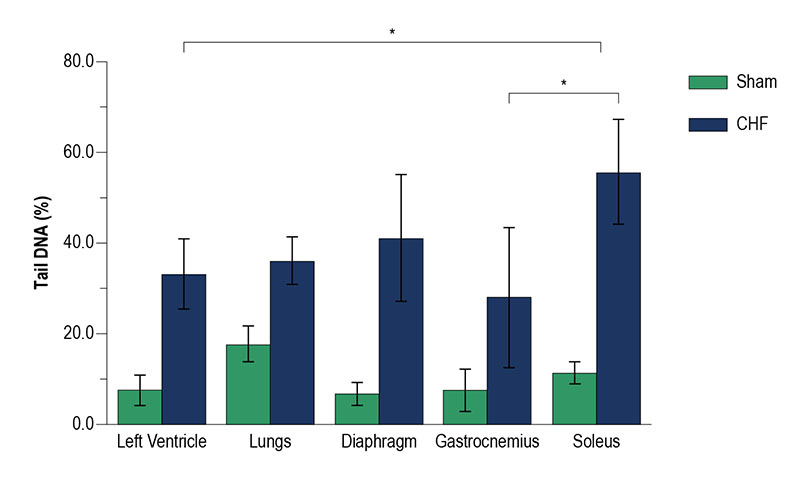Volume 114, Nº 2, February 2020
DOI: https://doi.org/10.36660/abc.20180198
ORIGINAL ARTICLE
Quantification of DNA Damage in Different Tissues in Rats with Heart Failure
Giuseppe Potrick Stefani
Ramiro Barcos Nunes
Douglas Dalcin Rossato
Vitor Scotta Hentschke
Marlise Di Domenico
Pedro Dal Lago
Cláudia Ramos Rhoden

Figure 2 – DNA damage in different tissues, according to % tail DNA, induced by CHF. Quantification of DNA damage in isolated cells of left ventricle, lungs, diaphragm, gastrocnemius and soleus muscles in Sham-operated rats and rats with CHF. Sham (n = 6), CHF (n = 6). Two-way ANOVA, with post-hoc test of Tukey. * p < 0.05 vs. Soleus.
Abstract
Background: Chronic heart failure (CHF) is a complex syndrome which comprises structural and functional alterations in the heart in maintaining the adequate blood demand to all tissues. Few investigations sought to evaluate oxidative DNA damage in CHF.
Objective: To quantify the DNA damage using the comet assay in left ventricle (LV), lungs, diaphragm, gastrocnemius and soleus in rats with CHF.
Methods: Twelve male Wistar rats (300 to 330 g) were selected for the study: Sham (n = 6) and CHF (n = 6). The animals underwent myocardial infarction by the ligation of the left coronary artery. After six weeks, the animals were euthanized. It was performed a cell suspension of the tissues. The comet assay was performed to evaluate single and double strand breaks in DNA. Significance level (p) considered < 0.05.
Results: The CHF group showed higher values of left ventricle end-diastolic pressure (LVEDP), pulmonary congestion, cardiac hypertrophy and lower values of maximal positive and negative derivatives of LV pressure, LV systolic pressure (p < 0.05). CHF group showed higher DNA damage (% tail DNA, tail moment and Olive tail moment) compared to Sham (p < 0.001). The tissue with the highest damage was the soleus, compared to LV and gastrocnemius in CHF group (p < 0.05).
Conclusion: Our results indicates that the CHF affects all tissues, both centrally and peripherically, being more affected in skeletal muscle (soleus) and is positively correlated with LV dysfunction. (Arq Bras Cardiol. 2020; 114(2):234-242)
Keywords: Heart Failure; Rats; Rats Inbred Strains; Tissue Distribution; DNA Damage; Comet Assay.















